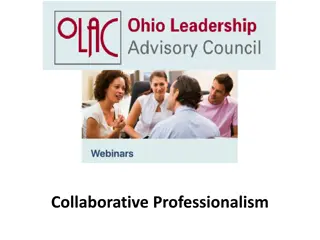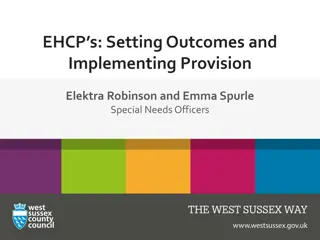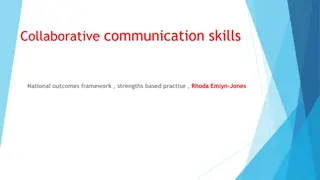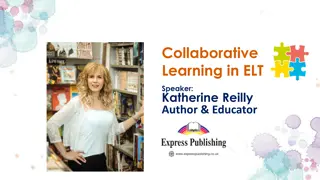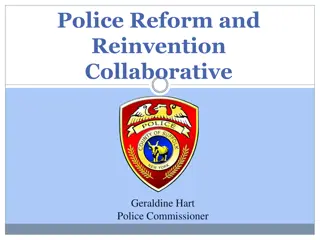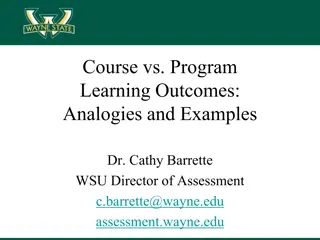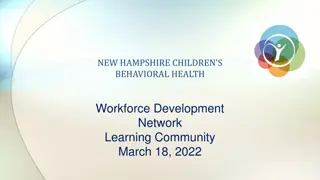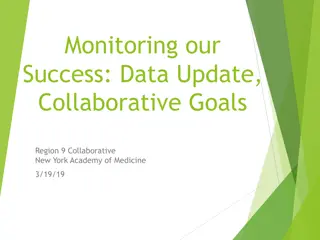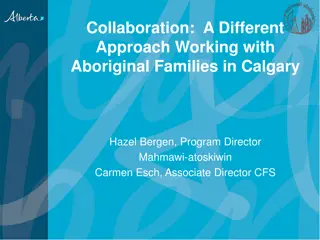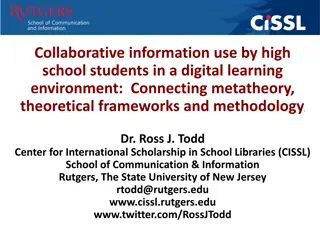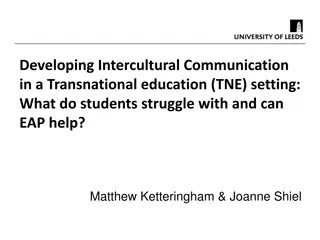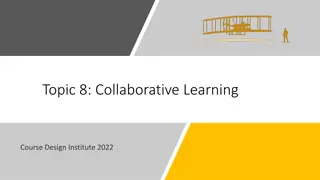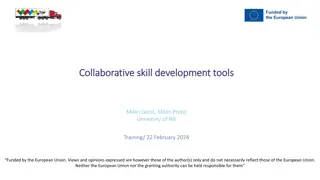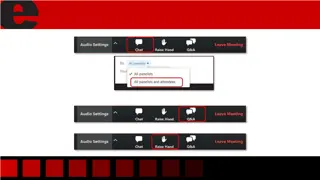Enhancing Collaborative Education for Better Outcomes
Explore the world of Interprofessional Education (IPE) and Interprofessional Practice (IPP) in the Department of Speech, Language, and Hearing Sciences. Learn how collaboration between different professions can improve outcomes for individuals and families. Discover the importance of IPE in education professions and its impact on service delivery. Dive into the definition of IPE according to the American Speech-Language and Hearing Association (ASHA) and how it promotes effective collaboration. Uncover the development of IPE as a continuum for supporting individuals and families.
Download Presentation

Please find below an Image/Link to download the presentation.
The content on the website is provided AS IS for your information and personal use only. It may not be sold, licensed, or shared on other websites without obtaining consent from the author. Download presentation by click this link. If you encounter any issues during the download, it is possible that the publisher has removed the file from their server.
E N D
Presentation Transcript
Interprofessional Education Introduction Department of Speech, Language and Hearing Sciences & National Student Speech, Language and Hearing Association Aunusha Sundarrajan & Nancy Robinson
Interprofessional Education for Inclusive Schools Defining Interprofessional Education (IPE) and Interprofessional Practice (IPP) Application of IPE in Education Professions What do IPE and IPP Look Like? Resources to Develop IPE IPE Case-Study Discussions Evaluation and Wrap-up
Defining Interprofessional Education The American Speech-Language and Hearing Association (ASHA) adapted the World Health Organization s definition of Interprofessional Education (IPE): an activity that occurs when two or more professions learn about, from, and with each other to enable effective collaboration and improve outcomes for individuals and families whom we serve.
Interprofessional Education (IPE) and Interprofessional Practice (IPP) How are IPE and IPP related? We all work in settings where collaboration is necessary for optimal programs for the people we serve. However, focused attention to building skills for collaboration are not uniformly addressed in pre- professional training. Education in effective collaboration across disciplines (IPE) leads to improved outcomes in service delivery (IPP).
What distinguishes IPE? Multidisciplinary Education Interprofessional Education Students from different degree programs may participate in same classes together. Students about, from and with each other in exchanges about the shared content. Shared learning focuses from learning same content together. Shared learning is focused on integration of knowledge in providing services for individuals. Focus remains on acquiring depth of knowledge and skill in individual disciplines, working parallel with others. Interprofessionalism results from application of all perspectives of team members in providing services.
Development of Interprofessional Education as a Continuum Interprofessional Education: Includes previous models in a comprehensive system to best support individuals & families Multidisciplinary Education: Appreciation and respect for each professional role Interdisciplinary Education: Professionals work together to coordinate services
Principles of IPE Principle #1. IPE/IPP is not a replacement for rigorous education specific to each health care profession. This indicates that interprofessional identity complements but does not replace professional identity. Principle #2. IPE/IPP represents one solution not all solutions to the problems of the health system. Principle #3. Experiential and team-based learning are the hallmarks of IPE/IPP.
What do IPE and IPP Look Like? Interprofessional Education Collaborative Competency 1. Values/Ethics for Interprofessional Practice: Work with individuals of other professions to maintain a climate of mutual respect and shared values. Competency 2. Roles/Responsibilities: Use the knowledge of one s own role and those of other professions to appropriately assess and address the health care needs of patients and to promote and advance the health of populations. Competency 3. Interprofessional Communication: Communicate with patients, families, communities, and professionals in health and other fields in a responsive and responsible manner that supports a team approach to the promotion and maintenance of health and the prevention and treatment of disease. Competency 4. Teams and Teamwork: Apply relationship-building values and the principles of team dynamics to perform effectively in different team roles to plan, deliver, and evaluate patient/ population-centered care and population health programs and policies that are safe, timely, efficient, effective, and equitable.
How is your IPP Development? Take a few moments to evaluate your own development of competencies for IPP. What do you see as your particular strengths? What areas can you identify that require further professional development?
How is IPE Applied to Clinical & Educator Preparation? Interprofessional Education and Practice respond to patient safety crisis in health care in order to improve quality. Interprofessional Education Collaborative (IPEC) established in 2011with schools of Medicine, Nursing, Osteopathic Medicine and Public Health, now expanding to other health disciplines. The American Speech, Language and Hearing Association joined IPEC in 2017 and included IPE & IPP in certification standards for SLPs and AuDs. SLP and AuD students develop skills to build partnerships with community-based facilities. Clinical preparation for SLPs and AuDs create meaningful experiences in which members of the various health care professions could learn together. IPE interactions would be team based and patient centered. In Education, federal and state initiatives create relevance for IPE and IPP for high- performing schools that are accountable to engage ALL learners. Multi-Tiered Systems of Support require that all members of the school team work in a coordinated system to support ALL students. Inclusive education practices require that each member of the school team learn from each other. IPE supports development of integrated educational plans that includes needs of families and students with diverse learning and language needs
Educator Preparation Standards and IPE California Teaching Expectations for ALL Teachers (effective 2017 for MSC and Secondary, 2021 for Education Specialists) TPE 1: Engaging and Supporting All Students in Learning (includes application of MTSS) TPE 2: Creating and Maintaining Effective Environments for Student Learning TPE 3: Understanding and Organizing Subject Matter for Student Learning TPE 4: Planning Instruction and Designing Learning Experiences for All Students TPE 5: Assessing Student Learning TPE 6: Developing as a Professional Educator
IPE/IPP and Inclusive Practices in Schools IPE/IPP Value & Ethics for IPP Inclusive Practices Full Participation Roles & Responsibilities Universal Design for Learning Team Collaboration IP Communication Family, Student, Community Partnerships Teams & Teamwork Professional Development IPEC IPEC TASH TASH
GCOE Prepares the Whole School Team EdD in Educational Leadership Joint Ph.D. in Special Education Special Education (All Programs) Interprofessional Education for Inclusive Schools Equity, Leadership Studies and Instructional Technology (All Programs) Speech, Language and Hearing Sciences (Speech- Language Pathology & Audiology) Elementary Education (All Programs) Secondary Education (All Programs)
Resources to Develop IPE All materials and more are provided in GOOGLE File at this link: https://drive.google.com/drive/folders/1qxk0f2VRh6U5yr5H4UFH1N MjPF4lHtR3?usp=sharing Online Tools and Resources for IPE such as PechaKucha, for brief multi- media presentation and Infographic to create customizable charts, beginning on page 53 of the e-Reader on IPE at: https://www.asha.org/uploadedFiles/IPE-IPP-Reader-eBook.pdf Resources to implement Interprofessional Education Programs at University of Washington Center for Health Sciences Interprofessional Education Research and Practice at: https://collaborate.uw.edu American Speech-Language and Hearing Association resources for IPE/IPP for SLPs and AuDs at: https://www.asha.org/Practice/Interprofessional-Education-Practice/ Agency for Healthcare Research and Quality (AHRQ) has developed a teamwork system, Team Strategies and Tools to Enhance Performance and Patient Safety (TeamSTEPPS Core Curriculum; AHRQ, 2015), which is designed to reduce medical errors in medical settings
Case Study Discussions Approximately 40 minutes Introductions and background of each member. Volunteer to read the case study aloud. Follow discussion questions as a guide, with contributions from each member in the group. Volunteer to keep notes on table easel re: discussion. Summarize key points before moving on to the next question. Allow approximately 8 minutes per question. Summarize discussion on easel to share with large group.
Evaluation Complete evaluation in paper form or online at following link!
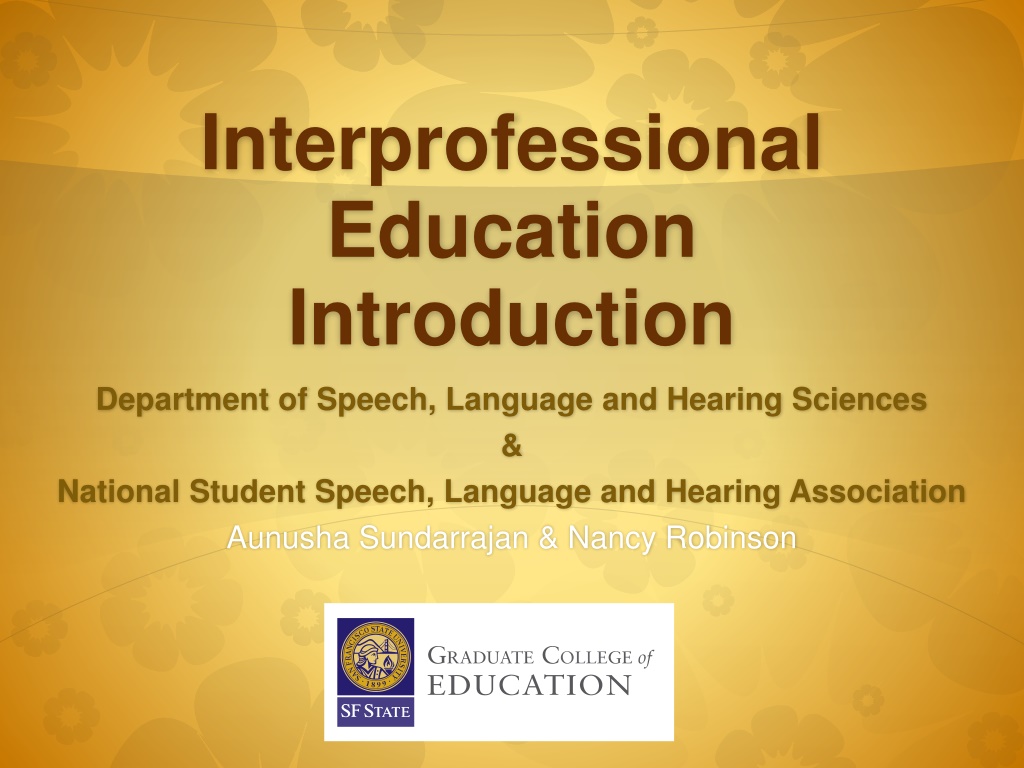
 undefined
undefined




